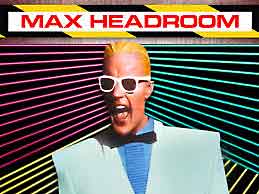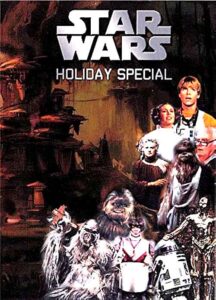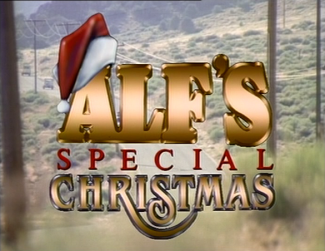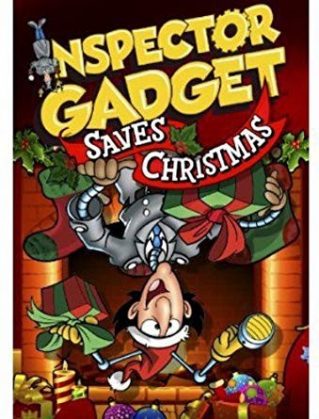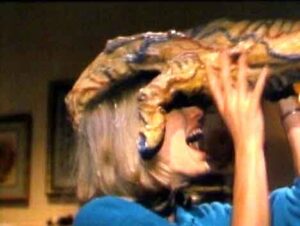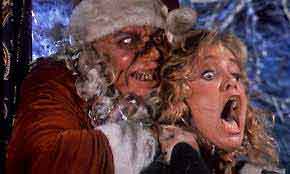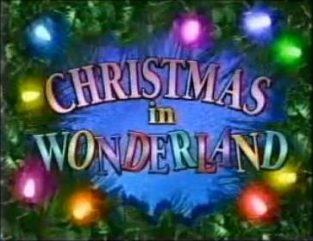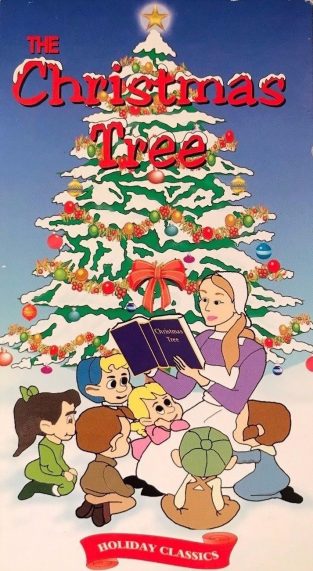Christmastime in America “means” several things, one in particular: a surfeit of TV specials. I no longer keep up with such programs, but did in my earlier years, which explains why so many of the following specials hail from the 1980s, my coming-of-age period.
TV Christmas specials then (and probably now) tended to have a number of common elements, starting with an overload of manufactured holiday cheer. Such was the case with 1986’s MAX HEADROOM CHRISTMAS SPECIAL, a program I’ve already covered in some detail, and so won’t analyze too deeply here.
Suffice it to say that the show features the holographic Max Headroom (a pop culture icon for a few minutes in the late 1980s incarnated by actor Matt Frewer), chatting with Robin Williams, Bob Geldof and Tina Turner, warbling holiday tunes and pontificating (read: babbling) in his inimitable stuttering, motor-mouthed manner. I wouldn’t call this show good, but it is engaging and amusing, and probably the single “best” program in this entire survey.
It’s certainly superior to the STAR WARS HOLIDAY SPECIAL from 1978, an attempt by George Lucas to maintain public awareness of the previous year’s STAR WARS and keep the merchandise selling.
STAR WARS HOLIDAY SPECIAL
It contains no explicit Christmas references, but does feature segments set on Chewbacca’s home planet, and appearances by Diahann Carroll, Art Carney, Bea Arthur and the main cast of STAR WARS, and also a cartoon from the Canadian outfit Nelvana (from whom we’ll be hearing more below). The best parts are the vintage commercials, of which a spot for the STAR WARS Kenner toy line, which provided this beyond-awful program’s primary reason for being, is (appropriately) the last and lengthiest.
Here we’ll jump forward nine years to an equally insufferable X-mas folly: the 1987 “Ooga Mooga” episode of SMALL WONDER. An especially ludicrous science fiction tinged child-oriented sitcom, SMALL WONDER featured a robot girl named Vikki (Tiffany Brissette) who lived with an ordinary suburban family. In “Ooga Mooga” a living doll (actually a very human woman pretending to be a doll) is purchased for a Christmas party stage act with Vikki. There’s little-to-no Christmas sap here, with zero mention of Santa Claus, snow or gift-giving, which is the program’s one major virtue IMO (although there is, as in every episode of SMALL WONDER, a tacky special effect, depicting Vikki flapping her hands and levitating).
SMALL WONDER OOGA MOOGA
No such luck, alas, with the vomitously holiday-fied ALF’S SPECIAL CHRISTMAS. Surely you remember ALF?
It was a (much) dumber than average kiddie sitcom about a furry alien puppet who, like SMALL WONDER’S Vikki, lived with a suburban family. In this 1987 two-parter, Alf gets separated from the family on Christmas and somehow winds up in a hospital. There he comforts a little girl who’s about to die from some unspecified illness, delivers a baby and talks a department store Santa—played, in a rare example of progressive eighties TV casting, by a black man—out of committing suicide. It’s all as outrageously mawkish as can be imagined, although the intrusive laugh track constantly undercuts the sap, as does the un-cheery dying girl subplot, which has led to this being called the “most depressing Christmas special ever.”
ALFS SPECIAL CHRISTMAS
The following year provided CHRISTMAS AT PEE-WEE’S PLAYHOUSE. PEE-WEE’S PLAYHOUSE featured Pee-Wee Herman, a.k.a. Paul Reubens, in a gaudy playhouse packed with robots and talking furniture, where he essentially acted like himself (i.e. a manic asshole). Pee-Wee does just that in this particular episode, during which Whoopie Goldberg, Dinah Shore and Oprah Winfrey turn up on a TV monitor, Magic Johnson appears inside the “magic Screen” (in which Pee-Wee and Magic are composited into cut-rate animated snowscapes), Grace Jones sings an abbreviated version of “The Little Drummer Boy,” Frankie Avalon and Annette Funicello make Christmas cards and Charro sings “Feliz Navidad” in a section devoted to Christmas in Mexico (in which Pee-Wee, upon being told that kids there celebrate by whapping piñatas, excitedly asks “You get to break things for Christmas?”). For Pee-Wee fans it’s a program of obvious interest, but for the rest of us this special stands as a reminder that the man worked best in small doses, and was downright obnoxious in stretches lasting over five minutes (see BIG TOP PEE-WEE for confirmation).
CHRISTMAS AT PEE-WEE’S HOUSE
Speaking of partially animated kids’ shows, each episode of the SUPER MARIO BROTHERS SUPER SHOW, a program based on the popular SUPER MARIO BROTHERS Nintendo game, contained a live action wraparound and a cheaply animated narrative. In this 1989 instance the former was a silly thing called “Little Marios,” in which the Mario Brothers (Lou Albano and Danny Wells) talk a would-be runaway out of leaving home, while the animated portion is “Koopa Klaus,” in which the brothers’ chief antagonist Koopa, a Grinch-like freak, decides to end Christmas.
SUPER MARIO BROTHERS SUPER SHOW: KOOPA KLAUS
The animated Marios take Koopa on in a succession of skirmishes scored with video game bleeps and whirs—and yes, the expected lectures about the spirit of Christmas are fully present. The best that can be said about “Koopa Klaus” is that it’s about on the same level, quality-wise, as the 1993 SUPER MARIO BROTHERS feature (although that, of course, isn’t saying much at all).
Still more cheap-o animation can be found in 1992’s INSPECTOR GADGET SAVES CHRISTMAS. Inspector Gadget was a bionically endowed police inspector voiced by the inimitable Don Adams, in a cartoon program that was memorable chiefly for its catchy theme song. In INSPECTOR GADGET SAVES CHRISTMAS Santa’s workshop is taken over by the evil Dr. Claw, who at the end of every INSPECTOR GADGET episode intoned “I’ll get you next time, Gadget!”
INSPECTOR GADGET SAVES CHRISTMAS
Here Claw uses electricity to turn Santa’s elves into mindless drones who do his bidding, with his ultimate aim being to deliver defective toys to the world’s children. It’s up to Gadget, who happens to be using his technological knowhow to visit the North Pole, to “save” Christmas (why is it that in so much Christmas themed media someone is either stealing or saving the holiday?). This he does, but not until after mistakenly arresting Santa Claus and getting into all sorts of silliness.
For those of you who like your holiday cheer spiced with scares, I’d recommend the 1986 “Seasons of Belief” segment of the anthology program TALES FROM THE DARKSIDE. Written and directed by the horror novelist and sometime screenwriter (of BEETLEJUICE and THINNER) Michael McDowell, it has the parents of two impressionable kids trying to scare the tykes with a story about the Grither, a big green monster who flies around on Christmas Eve as a rival to Santa Claus; in the nasty ending, we discover this monstrous creation is far more real than anyone suspected. As with most DARKSIDE episodes this one is noticeably cheap-looking (particularly in the climactic special effects), but quite affecting in its focus and simplicity.
Yuletide scares can also be found in the generously budgeted 1989 TALES FROM THE CRYPT episode “And All Through the House.” It was directed by Robert Zemeckis, who has an evident love for the sort of black-humored mirth on display in DEATH BECOMES HER (1992), the AMAZING STORIES episode “Go to the Head of the Class” (1986) and this teleplay, scripted by NIGHT OF THE CREEPS’s Fred Dekker and starring the late Mary Ellen Trainor. She plays a woman who on Christmas Eve decides to kill her husband, just as a homicidal maniac dressed as Santa Claus turns up in her neighborhood. That’s an admittedly thin premise, but Zemeckis’s directorial flair holds it together, and for once there’s no holiday sloganeering (with the closest thing to a Christmas Message being the Crypt Keeper’s final smart-assed refrain: “Be careful what you “axe” for this Christmas…you just might get it!”).
Continuing with the abovementioned AMAZING STORIES, we arrive at “Santa ‘85,” which hailed from season one of that Steven Spielberg produced anthology program.
AMAZING STORIES: SANTA 85
Slicky and showily directed by Spielberg protégée (and THREE O’CLOCK HIGH director) Phil Joanou, it’s far more typical of 1980s holiday television than “Seasons of Belief” or “And All Through the House,” with Santa Claus (Douglas Seale) entering a kid’s house and setting off a high-tech burglar alarm, causing him to be jailed by a cop (Pat Hingle) who’s pissed that Santa didn’t give him the toy Buck Rogers ray gun he asked for as a rug rat. Here, though, Santa has a chance to finally right that wrong and provide Hingle with the desired toy gun—aaaaaaaaaaaw! (See also—or better yet, don’t—1988’s ERNEST SAVES CHRISTMAS, with Douglas Seale once again playing Santa C. in a narrative with many similarities to this one.)
CHRISTMAS IN WONDERLAND was a downright insufferable 1991 episode of the ALICE IN WONDERLAND inspired Disney program ADVENTURES IN WONDERLAND. Here Alice (Elisabeth Harnois) walks into a mirror and enters wonderland, where the Red Queen (Armelia McQueen) of Lewis Carroll’s classic is putting together a Christmas party.
CHRISTMAS IN WONDERLAND
The one thing the queen really wants is snow, even though it “never snows in wonderland,” although ultimately she realizes she has “the best gifts of all” in the form of her friends and family—and, of course, it’s Christmas, and Christmas is a time for miracles…
Leaving series television behind, let’s take a look at A COSMIC CHRISTMAS. Having premiered in 1977, it was the first of several TV one-offs made by the Canadian cartoon outfit Nelvana. In true Nelvana fashion, it grafts a sci fi wraparound onto more-or-less typical 20-some minute kiddie cartoon fodder, with a story about a UFO landing on Christmas Eve. Said UFO disgorges a trio of aliens (who closely resemble the three wise men of the gospels), to whom a young boy teaches the True Meaning of the season. There’s also a flying bicycle and a spaceship that flashes colors in the shape of a Christmas angel, all done up in Nelvana’s trademarked funky-exaggerated animation style. Dumb, but also compellingly weird.
A COSMIC CHRISTMAS
This leaves us with the most appalling and notorious Christmas TV special of them all: the 43 minute animated loaf THE CHRISTMAS TREE from 1991, which is often referred to as the “ROOM of Christmas specials.”
The only film to be directed by the prolific Disney animator Flamarion Ferreira, the pic is downright excruciating, so much so that I found it all-but impossible to sustain interest in the jumbled narrative (hence the abbreviated, and probably inaccurate, plot summary below). It’s the opposite, in other words, of the type of so-bad-it’s-good cinema suggested by the ROOM comparison, being just plain rotten.
THE CHRISTMAS TREE
Comprised of lazy animation in which movements are constantly repeated and the characters’ lips rarely ever match the dialogue being spoken, it’s about some kids trapped in the home of the wicked Mrs. Mavilda, who forces them to do slave labor. They find solace in the form of a tree outside which they name Mrs. Hopewell. Eventually the old woman tries to chainsaw the tree, leading to Santa Claus appearing in the sky in his sleigh and zapping her with lightning. There’s more to it, of course, but I see no point going into any more detail. If anything, I’ve said too much already about a program that you’re better off simply not watching.

